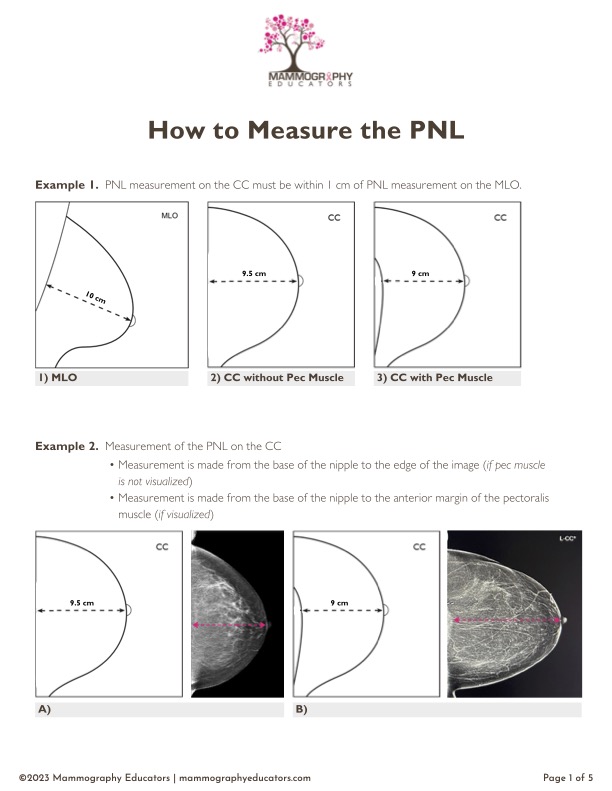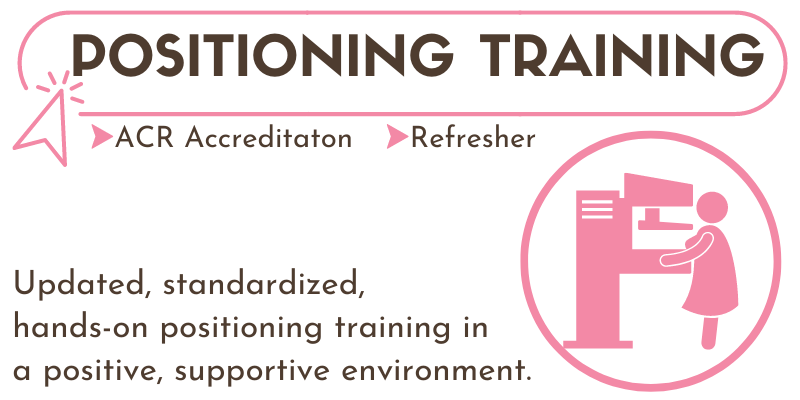Written by: Louise Miller, R.T.(R)(M)(ARRT), CRT(M), FSBI, FNCBC
I have noticed the same questions coming in during the Q&A session at the end of our live webinars and conferences, in our online Quality Breast Imagers Facebook group and when I am onsite as a consultant, working with technologists and radiologists. It seems there needs to be clarity around some of the same issues. So I thought why not try to clear up two of these common misunderstandings. If you’re someone who wants clarification around the PNL and ACR accreditation, keep reading!
Measurement of the PNL
I am starting with the PNL because the understanding about how to do this is pretty much “all over the map”. Working with this measurement has been handed down in a sort of oral tradition from rad to rad and tech to tech. Since I have seen some crazy versions, I’d like to clarify my understanding of the process.
We have additional handouts available on our resource page, which include a lot of visuals, which I think you will find very helpful.
Here is the bottom line when it comes to the CC, as I understand it from the former Chair of the ACR Accreditation Committee, Dr. Jean Weigert:
- The PNL measurement on the CC must be within 1 cm of the PNL measurement on the MLO
- The PNL measurement on the MLO must be within 1 cm of the PNL measurement on the CC

Measurement of the MLO
I unfortunately have not seen a written statement from ACR or SBI on these methods, but as I have given lectures on this topic for SBI, I would assume someone would correct me if I was wrong.
- On the CC, the measurement is made from the base of the nipple (skin line) to the anterior margin of the pectoralis muscle or the edge of the image. You can use whichever measurement is greater.
- On the MLO, the measurement is made from the base of the nipple (skin line) to the anterior margin of the pectoralis muscle where the muscle forms a 90 degree angle with the PNL.
ACR Criteria
I always find it interesting when I see images posted on social media asking the question, “Will these pass the ACR?”. A flurry of techs respond, mostly with different answers. (Oh my!) While these answers are meant to be helpful, there are a lot of different opinions and I wonder if the person who asked the question leaves feeling even more confused?! I must say however, that the consensus is usually correct, from my point of view.
The funny thing though, even though the criteria has been spelled out and the evaluation form used by the ACR is available to us, it is going to be a subjective analysis by the reviewer.
ACR Criteria Secrets
I used to tell people that I had heard if you miss the 1cm rule on the PNL, it is an auto fail. However, I don’t really know that to be true as I have never attended a training course held by ACR reviewers. I also don’t know how they evaluate the IMF... Does it have to be completely visualized on both MLOs Does it have to be open? And how does one evaluate “open”? I have looked at many IMFs with my fellow mammo buddies... We could sit around and look at IMFs all day long and still not all agree on if it is open or not. Then again, what is the reviewer’s perspective?
Another rumor I heard many years back is that the ACR would fail all images done on the large platform (Bucky at the time) or large compression paddle in the days of digital and tomo. I know this not to be true because we submitted large breasts and they passed. I think perhaps that the rumor started because many large breasts were hard to keep from drooping excessively and perhaps they failed for that reason?
Another recent rumor was that the muscle must be convex, making straight muscle unacceptable. I find this odd as the image criteria stated in the ACR Manual (published in 1999... I know, sigh!) states that straight is acceptable. Again, I am not 100% positive as I am not a reviewer, but I have made it my mission to find out. I have contacted the current Chair of the ACR Accreditation Committee for some clarification, so stay tuned for more ACR secrets!
A Special Thanks to YOU!
I hope all this makes sense and though I wish I had more definitive answers with references to back me up, these may help to clear up some of the confusion surrounding these two issues. Thanks again for all you are doing on the frontline of healthcare during these most challenging times. Stay safe and hang in there.



